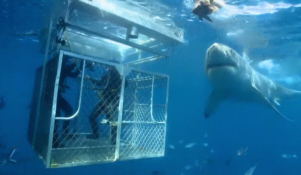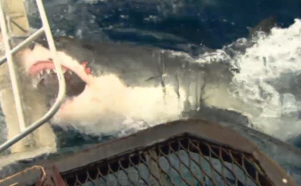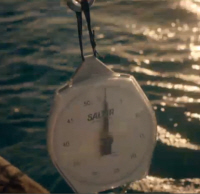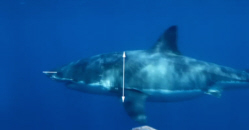Great White Shark
Carcharodon carcharias
Size Matters?

Brian Cox aboard Ship
I'm heading out to the Neptune islands, west of Adelaide in South Australia… In search of one of nature's largest killing machines. These beasts are
feared around the world, a fear not helped by Hollywood filmmakers. I'm here to swim with great white sharks.
How big… How wide can they open their jaw?
Crew member "Three foot wide."
About three feet, They can swallow a man whole?
Crew member "Yes."
The skipper has a special permit to use bait to lure the sharks in. The crew ready the cages.
Great White Shark - Carcharodon carcharias
The last time I dived was in the marina in Brighton. I did see a fish. From that to the largest marine predator.
As the sharks start to circle, it's time to get in. There he is. There he comes . just look at that. He's just checking us out. Well, he's
turning straight for us. Look at those teeth. Graceful, elegant thing. Shaped by natural selection. Brilliant at what it does, which is to
eat things.

Shark Cage
Well, I never would have thought you could be that close to one of those. Great Whites are highly evolved predators. Around two thirds of their
brain is dedicated to their sense of smell. They can detect as little as one part per million blood. In this water, the tiniest speck of blood…
will attract the sharks.
These fish can grow to a huge size. But still move with incredible speed and agility. They've been sculpted by evolution, acting within the bounds
of the physical properties of water.
Now, he's about 5 metres long. He weighs about a ton. And he's probably the most efficient predator on Earth. When he's attacking, he can accelerate
up to over 20 miles an hour. They can launch themselves straight out of the water.

Great White Shark Attack
That was one of the most awe-inspiring sights I've ever seen. A Great White, just straight in front of me with its mouth open.
With the boat moored up, away from shark-infested waters, I want to explore why it's in our oceans that we find the biggest animals on Earth. From
giant sharks to blue whales, the largest animals that have ever lived have lived in the sea. The reason why is down to physics.
This is a container full of salt water and I'm going to weigh it. You see, that says 25 kg there. That's actually its mass. Its weight is the
force the Earth is exerting on it due to gravity, which is 25 times about ten, which is 250 kg metres per second squared. that might sound pedantic,
but it's going to be important in a minute.

Zero Gravity
See what happens if I lower this salt water into the ocean. Its weight has effectively disappeared. It's effectively zero.
Now, of course, gravity is still acting on this thing, so by the strictest sense of the word, it still has the same weight as it did up here,
but Mr Archimedes told us that there is another force that comes into play. There is a force proportional to the weight of water that's been displaced
by this thing and because of this thing is essentially the same density as seawater, because it's made of seawater, then that force is equal and opposite
to the force of gravity, and so they cancel, so it's effectively weightless and that is extremely important indeed for the animals that live in the ocean.
The cells of all living things are predominantly made up of salty water so in the ocean, weight is essentially unimportant. Because of Archimedes'
principle, the supportive nature of water releases organisms from the constraints of a Earth's gravity, allowing the evolution of marine leviathans.
But this comes at a cost. Water is 800 times denser than air and so whilst it provides support, it requires a huge amount of effort to move through it.
Not only does the shark have to push the water out of the way, it also has to overcome drag forces created by the frictional contact with the water
itself. The solution for the shark lies in its shape. If you look at him, that great White, he's got that distinctive streamlined shape.

Streamlined Shark
His maximum width is about a third of the way down his body, and that width itself should be around a quarter of the length. That ratio is set by
the necessity for something that big to be able to swim effectively and quickly through this medium.
This shape reduces drag forces to a minimum and optimises the way water flows around the shark's body. It is in the result of evolution, shaped
by the laws of physics.
That streamlined shape of a shark is something that you see echoed throughout nature. I mean, think of a whale or a dolphin or a tuna, all that
same torpedo-like shape, and that's because they're contending with problems that arise from the same laws of physics and convergent evolution has
driven them to the same solution.
For life in the sea, the evolution of giants is constrained directly by the physical properties of water. But out of the ocean, life now has
to contend with the full force of Earth's gravity. And it's this force of nature that dominates the lives of giants on land.




